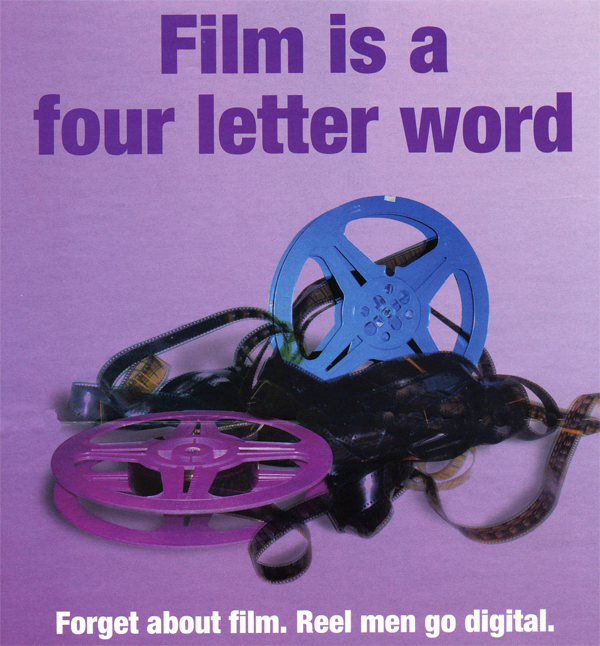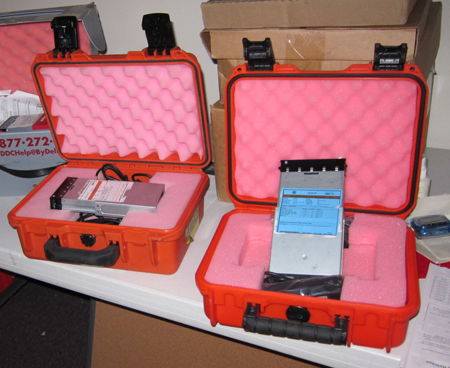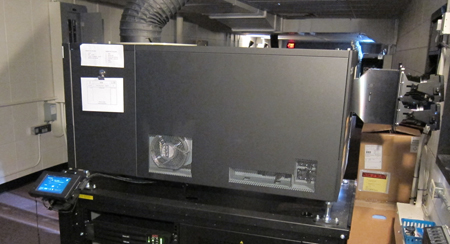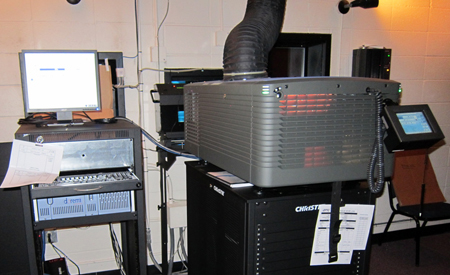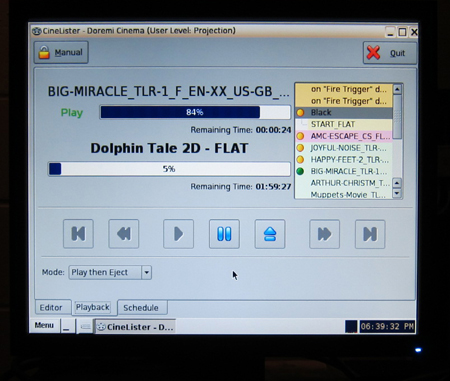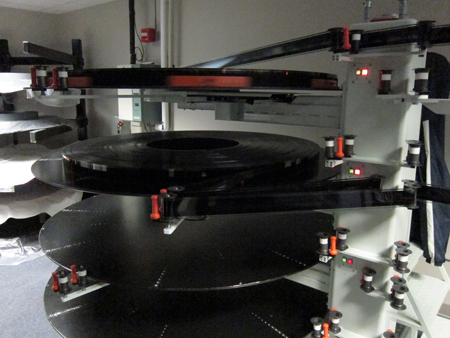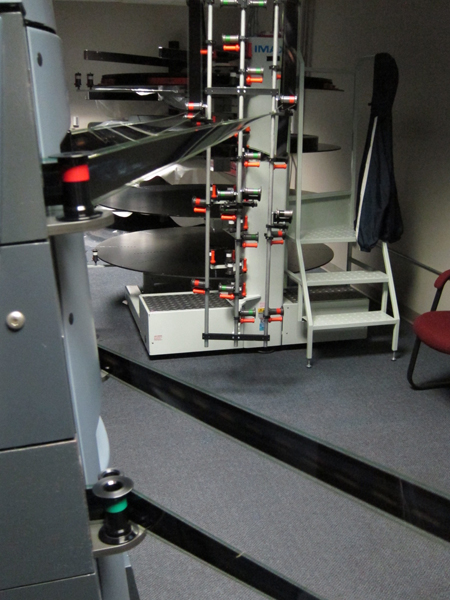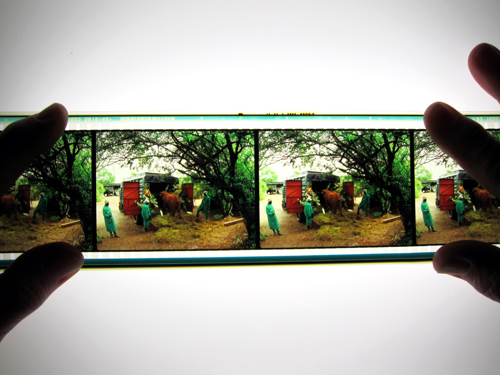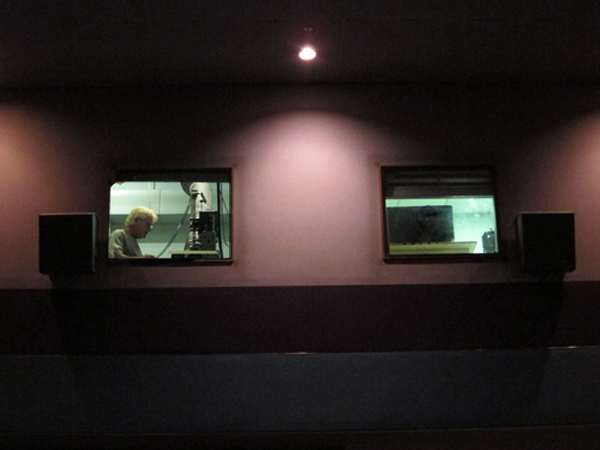Pandora’s digital box: In the multiplex
Thursday | December 1, 2011 open printable version
open printable version
Advertisement for NEC digital projectors, Variety July 2005.
ELECTRONIC CINEMA IN THE WINGS
Not only will [HDTV] usher in a new era of dramatically enhanced sharper-picture, improved color, wide-screen, stereophonic home TV, but HDTV will give rise to what’s already being called “electronic cinema”—high-definition video used to make 35mm quality theatrical feature films.–Variety, January 1982
FAROUDJA TOUTS VIDEO FOR BIGSCREEN
Faroudja and Videac seek to demonstrate that today’s technology makes it quite possible to display video images in a theatrical environment of a quality that can stand comparison with 35mm film. —Variety, June 1989
DIGITAL TECH POINTS TO PIX’ FUTURE
In the midst of a digital revolution that is embracing television, cable, and telephones, the movies certainly aren’t immune. Appearing soon in a theater near you will likely not be film at all but a digital projection that looks like the real thing. —Variety, May 1992
DIGITAL CINEMA HOVERS ON HI-TECH HORIZON
“I really do think at least a couple of the major players are pretty close.”–Variety, June 1995
WHEN PRINTS WILL NO LONGER BE KING
While the eventual replacement of 35mm projectors by video systems was seen as an inevitability—and a welcome one, at that—most agreed it was still far in the future. But after seeing six state-of-the-art systems beam images onto a 40-foot-long screen at the United Artists Denver Pavilions complex, many attendees agreed that the future is already upon us. — Variety, January 1999
Aug. 15, 2004: Using his computer keyboard and mouse, the president of top U.S. theater chain Regal/ Loews-AMC books the upcoming weekend’s films into his circuit’s theaters.
As he clicks on the titles (“Austin Powers 4: You Only Shag Twice,” “The Matrix III,” and MGM’s long-awaited “Supernova”) the films begin downloading via satellite to the circuit’s digital megaplexes around the globe. —Variety, August 1999
DIGITAL CINEMA’S PICTURE STARTS TO FADE
A few years ago, cinema operators were open-minded, but not any more. Now it’s clear that the first-generation digital projectors—brand-spanking-new equipment installed in 116 screens worldwide, out of an estimated 108,000 cinema screens globally—is rapidly becoming obsolete. — Variety Deal Memo, July 2002
AT LONG LAST, DIGITAL THEATERS
Finally. Digital cinema is here. No, really. . . . The conversion of of 35,000 US screens to digital projection can begin in earnest.
. . . . All six “Star Wars” films will be converted for 3-D re-release, perhaps as soon as 2007. —Variety, July 2005
DB here:
Reading things like this over the last couple of decades, I smiled patronizingly. The shift to digital, hyped from the start, sounded both inevitable and impossible. Even the ad for NEC at the top didn’t faze me. I’ve seen braggadocio before.
In my smugness I forgot that most broad changes take a long time to be consummated. Historian Jim Cortada writes that a new technology may wait as long as forty years before an industry decides to adopt it. I should have remembered that in cinema many hardware changes, such as color movies, took a surprisingly long time to become dominant.
Now everybody has woken up. We realize that we’ve crossed a threshold. Henceforth digital projection will be the norm.
Some numbers back up the impression. In December 2000 the world had 30 commercial digital cinema screens. In 2005 it had 848. At the end of 2010 it had 36,103—about thirty per cent of the total 123,067 screens. In North America, the jump was dramatic, from about 330 d-screens at the end of 2005 to over 16,000 at the end of 2010.
This year has iced the cake. In the UK, 80 % of releases were digital. At Cannes there were a great many digital screenings, even of films shot in 35mm. In Belgium the two major theatre chains, Kinepolis and UGC, went wholly digital. In Norway all 420 commercial screens were converted, partly because the government funded the changeover. Closer to home, the dominant chain in our region, Marcus Cinemas, went digital and fired its projectionists—ironically, just before Labor Day. My local theatres are junking their 35mm equipment. Roger Ebert recently posted a letter from Twentieth Century Fox announcing that “within a year or two” it won’t be sending out film prints.
Given all this, the newest predictions don’t look as Pollyannaish as the ones I listed up top. “Some time in 2013,” says a spokesman for the National Association of Theatre Owners, “all the [U. S.] screens will be digital.” Next year, half the screens in the world are likely to be. By 2015, predicts IHS Screen Digest, film-based projection will be defunct in commercial cinemas.
I’m not smirking now. Digital cinema is here.
The booth
“Here,” of course, is a place still in transition. I saw that back in September when I paid a visit to my local, an AMC multiplex in Fitchburg, Wisconsin. Its projection booth, a vast tunnel running almost the breadth of the building, reflected the changes in progress. Several 35mm projectors were still humming away, pulling the film from one big platter to another. There were some digital projectors too, one being the Sony SRX-R320.
You’ll notice the two lens housings on the right, suited to 3-D. Using these lenses for screening 2D films is a bone of contention in the current controversy about digital projection. (See the codicil for this entry.)
There was one Christie digital projector, run both from a computer and a touch-screen.
The heart of the system is the Digital Cinema Package (DCP), shown above. It’s a cute item, a little taller and skinnier than a trade paperback. It comes in a bright red carrying case padded with pink foam. Essentially, it’s a hard drive containing files for the image, sound, and subtitles, as well as files for playback, security, and encryption. The film is compressed; an hour-long movie at the maximum rate would take up about 115GB on a DCP. Trailers and specialized content, like Met Opera shows, come on their own DCPs.
The DCP files have to be opened, with password keys supplied by the distributor. The files are then loaded into either a projector or a server in the booth. Loading can take several hours. A projector like the Sony can hold half a dozen or more features. Since the projectors are essentially big computers, the features, trailers, ads, and the like have to be arranged in a playlist, accessed by either a touchscreen, a laptop, or both.
The fear of piracy has kept back one early aim of the digital cinema revolution: Delivery of content via satellite or the Net. These are apparently too vulnerable to hacking or crashing. So the DCP is delivered the old-fashioned way, by courier services like UPS and FedEx. The decryption keys are sent by email or by a much older technology: the telephone. Often exhibitors and projectionists—sorry, Mr. or Ms. Screen Management System—has to phone somebody to learn the codes to tap in.
Turning points before the tipping point
The digital switchover seems sudden, but like most historical change there’s a story to tell about it. The digital changeover in movie houses was delayed by many factors, but the problems were solved, as usually happens when there’s money to be made and people are in the grip of the next big thing.
Here are four factors that, to my mind now, made the difference. They didn’t crop up in neat sequence, but they developed in an intertwined fashion before gathering in a knot in the last year or two.
1. The setting of standards
Standards are of immense value to the film industry. It’s to everybody’s interest to have movies run at the same rate, but if you think you can improve on 24 frames per second (sometimes 25 in Europe), you will have a long climb. (Doug Trumbull and Dean Goodhill have found this in arguing for higher frame rates.) Technological change in Hollywood consists chiefly of the Majors cooperating with each other to mutual benefit, while setting up barriers to entry that exclude outsiders.
For the most part, standards in film have been set not by trade associations or government agencies but by the major players: the technology suppliers and the studios. Innovations in sound, picture, color, and widescreen tended not to come from within the filmmaking companies but from outside firms and lone inventors, eventually to be accepted by the majors. Only then do the trade associations and other institutions get into the act.
The standards are often in flux, constantly adjusted to practical concerns. What, for instance, is the CinemaScope aspect ratio? Designed originally to be 2.66:1, twice as wide as the 1.33 format, it went to 2.55 and then to 2.35, partly because of Twentieth Century-Fox’s responses to the market. Later that standard was modified again, to 2.40. The Society of Motion Picture Engineers, which has historically tried to stabilize the technical standards, often played catch-up, refining or revising standards that were already common practice on the ground.
The real momentum for standardization comes when the American film studios, as an oligopoly, decide to throw their weight behind an innovation. This is what happened with the DVD and the Blu-ray disc (and may happen with higher frame rates for digital). Once the decision-makers have surveyed the range of options out there, usually offered by very big technology companies, there ensues a process of negotiation, testing, and horse-trading before a standard is arrived at. And even then the standards might be pretty flexible.
For digital projection, the oligopoly’s concerted effort began in 2002, when the six major studios formed a joint venture, the Digital Cinema Initiatives, LLC. As the studios in the 1920s had recruited the American Society of Cinematographers to test incandescent lighting systems, so they now had the ASC create material for testing digital projectors. The DCI also hired universities and private agencies to test the systems. Some interim documents proposed requirements, and the full set of specifications was issued in July 2005. This 161-page document has been revised, but it remains the bedrock for any manufacturer, theatre chain, or projectionist (defined in the text as part of the “Screen Management System. . . the human interface for the Digital Cinema System”).
![]() The original document, available here, is a mind-boggler for anybody not familiar with the engineering of digital systems. It specifies image qualities, audio characteristics, metadata, encryption, and security parameters. Here’s a sample from the nineteen tasks assigned to the Security Manager (SM)—again, not a person but a program:
The original document, available here, is a mind-boggler for anybody not familiar with the engineering of digital systems. It specifies image qualities, audio characteristics, metadata, encryption, and security parameters. Here’s a sample from the nineteen tasks assigned to the Security Manager (SM)—again, not a person but a program:
Secure Processing Block behavior and suite implementations shall permit the SM to prevent or terminate playback upon the occurrence of a suite SPB substitution or addition since the previous suite authentication and/or ITM status query. The SMs shall respond to such a change by immediately purging all content and link encryption keys, terminating and re-establishing: a) TLS sessions (and reauthenticating the suite), and b) suite playability conditions (KDM prerequisites, SPB queries and key loads). “Prepsuite” command(s) shall be issued per (9) prior to the next playback.
This is a far cry from what projectionists and theatre managers have traditionally known how to do. The opacity of the DCI specs may have the effect of disempowering traditional film workers and shifting their responsibility to the maintenance manager working for the manufacturer or some other third party. In any case, as had happened with sound and widescreen systems, the American film companies set the standards for the world.
The publication of the DCI report led to the exuberance in my last quotation at the start. With this in place, surely digital cinema had arrived in 2005 (along with the imminent release of all six installments of Star Wars in 3D). Yet a report last March found that most projectors currently in use weren’t fully DCI compliant; Sony and other companies came up with fully compliant equipment only this year. So thousands of projection systems were in operation outside the DCI standard, working under the rubric of “interoperability.” As usual in the film industry, practical demands outpaced standardization. 2011’s new lines of projectors from major providers are DCI compliant, which should attract exhibitors who were hanging back to see how all this got sorted out.
2. Convergence of hardware
A key condition laid down by the DCI was a requirement that digital exhibition be 2K or 4K resolution. That eliminated some systems outright, notably the unsatisfactory 1.3K format that had had some take-up in the US and had proliferated in foreign markets such as India (and are still flourishing there under the name of “e-cinema”). 1.3K systems were in the majority until 2005.
For 2K or 4K projection, Texas Instruments had already developed its Digital Light Processing system, consisting of thousands of microscopic mirrors, and this was adopted by three major manufacturers: Christie, Barco, and NEC. Sony developed its own system using modified LCD technology, claiming that only that can do justice to 4K projection. These four companies dominate the digital theatre market. All were producing machines in numerous models by the end of the 2000s.
China and Russia, both growing markets, proved particularly important, as their newly built theatres skipped 35mm altogether. The expanding markets gave the companies vast quantities of business; Christie reported that over 600 sites in Asia installed its projectors in 2009, while Barco claimed that it had 80 % of all installed screens in China. In Russia, of the 297 new screens added in 2010, 256 were digital. This surge from the periphery gave impetus to the US changeover as well, as brisk sales permitted the manufacturers to refine their systems and hatch new models.
3. The Virtual Print Fee
Historically, exhibition has been the most conservative wing of the film business. The theatre owner has the most to lose if a new technology fails to catch on. It was theatre chains’ reluctance to install magnetic-stereo sound systems that led Twentieth Century-Fox to redefine CinemaScope to 2.35, lopping off some picture area to make room for an optical soundtrack that would play on existing projectors.
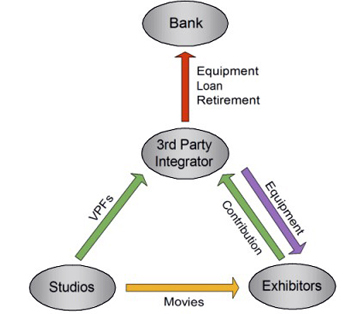 It’s expensive to retool a movie house for digital conversion. Each projector can run up to $100,000, and you need a server as well. In addition, the costs of maintenance are higher for digital; theatre owners initially claimed that they’d need up to $10,000 annually per auditorium.
It’s expensive to retool a movie house for digital conversion. Each projector can run up to $100,000, and you need a server as well. In addition, the costs of maintenance are higher for digital; theatre owners initially claimed that they’d need up to $10,000 annually per auditorium.
The big three theatre chains in the US—AMC, Regal Entertainment, and Cinemark—control about 20,000 of the country’s 39,500 screens, and they were reluctant to embrace a technology that could cost them a couple of billion or more. If these dominant exhibitors wouldn’t jump in, no smaller circuits would convert. Moreover, the studios preferred a quick conversion. Distributing both 35mm and digital versions was costlier than either one alone.
The solution was the Virtual Print Fee. Five studios agreed to help the big three finance the cost of conversion, to the tune of $1 billion. The VPF is a subsidy paid by the distributor. Under one common arrangement, it’s collected by an intermediary, known as a third-party integrator; the dominant integrators in the US have been DCIP and Cinedigm. The integrator loans the digital equipment to the theatre. For each booking the exhibitor makes, the film’s distributor gives a sum to the integrator (negotiable, but said in 2005 to be $1000 or so). But the VFP doesn’t cover the entire cost; the exhibitor has to chip in. Eventually the equipment is paid off and belongs to the exhibitor. (The accompanying diagram is taken from the informative site hosted by MKPE Consulting LLC.)
To speed up wide installation, most VPFs were set to expire at the end of 2012, although some are likely to be renewed or extended. Recently, Christie’s has initiated a VPF program aimed at independent exhibitors. Europe and Asia have VPFs and integrator go-betweens as well.
Most observers credit the VPF policy as a principal cause of speedier digital conversion, but there was another factor at work.
4. The killer app, 3D
The studios’ concerted offer of a Virtual Print Fee occurred in October of 2008, just as the world economy was heading down the drain. Credit was tight, and the rate of digital conversion was slowing. 3D came along at the right moment. Exhibitors learned that there was a line-up of big 3D films for 2009, all from the studios offering the VPF. A theatre that wasn’t set up for digital couldn’t play these titles.
Chicken Little (2005) showed the way, and in the following years a few films gave other promising results (Monster House, 2006; Meet the Robinsons, 2007). Concert films, especially Hannah Montana (2008), helped too. But Monsters vs. Aliens (2009), which played Imax houses as well as normal 3D ones, was a turning point: it grossed nearly $60 million in the US over its first weekend, more than half coming from 3D screens. The studios stepped up their production of 3D titles, from five in 2008 to eleven for 2009 and over twenty in 2010. Exhibitors saw that they could charge between $2 and $5 more for a 3D ticket, and this boost could help defray the costs of converting to digital presentation. Avatar seemed to seal the deal; it became the top-grossing film of all time (in absolute, not relative dollars), and after 47 days, over 80% of its $2.075 billion gross had come from 3D screenings.
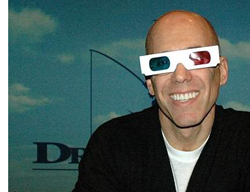 This year sees over thirty 3D releases. Kristin has pointed out that the calculations of 3D’s value to the box-office may be off-base. Still, the 3D initiative worked as a wedge prying open reluctant multiplexes. There are now over 22,000 3D screens worldwide, and in 2010, they yielded $6.1 billion in grosses–more than twice the 2009 figure. Hollywood should give Jeffrey Katzenberg (right) a medal for his insistence that this format was the wave of the future. Even if it’s not that, it was the Trojan Horse for digital projection.
This year sees over thirty 3D releases. Kristin has pointed out that the calculations of 3D’s value to the box-office may be off-base. Still, the 3D initiative worked as a wedge prying open reluctant multiplexes. There are now over 22,000 3D screens worldwide, and in 2010, they yielded $6.1 billion in grosses–more than twice the 2009 figure. Hollywood should give Jeffrey Katzenberg (right) a medal for his insistence that this format was the wave of the future. Even if it’s not that, it was the Trojan Horse for digital projection.
I haven’t touched on other forces working in favor of digital theatres. Exhibitors were surely happy to embrace an automated system that would allow them to dismiss expensive unionized workers. Digital projection also opened up the possibility of using a venue for “alternative content”–pop concerts, opera broadcasts, sports events, and business meetings with snazzy presentations. Distributors gained as well. Besides saving money on prints and shipping—the public rationale for the switch—distributors could now monitor the number of screenings at any venue. A DCP-wrapped feature is set for only a certain number of runs. To extend the number of screenings, the exhibitor needs a new key code. This prevents off-hours screenings, a common practice of old-school projectionists. In addition, distributors suspected projectionists of video-recording prints or bicycling them for overnight telecine copying. (After Web 2.0, however, prime sources of bootleg copies have been workers in the industry itself.)
The past regained
Historians shouldn’t predict. I succumb sometimes, but I always regret it later.
Even professional predictors shouldn’t predict, as we see from a 2002 Credit Suisse First Boston report on digital cinema. That document declared that Eastman Kodak was the technological “winner” and would benefit from its “sensible business plan.” The report added that Kodak’s film business should face “minimal deterioration” from digital cinema. They valued Kodak’s Entertainment Imaging branch at $2 billion. Today Kodak’s entire company is valued at $900 million and its stock trades at $1.10 per share, down from the $30s in 2002.
So, no predictions from me. But warnings and worries? Yes, quite a few. Next time I’ll share some concerns about festivals, repertory cinemas, arthouses, colleges and community centers who depend on 35mm prints—especially older titles, our link to the history of the medium. Eventually we’ll get to archives, the repository of said history. I hope as well to offer some general thoughts about the redefinition of “film” in the high-def era.
In the meantime, let’s remember what was.
Alongside the 35mm and digital houses at the AMC Star Fitchburg 18 stands a very good Imax facility. If the digital gear shows us the present and future, I had the feeling that the monstrous Imax 3D projector, devouring two huge reels of 70mm film at the same time, was the world’s last movie machine.
Two fat ribbons, destined to intersect for an instant, whir past you, zigzagging around rollers, turning the room into a web of film. A pair of images snap into the gate. Each is sprayed with a puff of air. You must keep the film and lens clean; even a speck of dust looks like Rodan on the Imax screen.
Holding 35mm film in your hand is a pleasure, but 70mm is almost menacing. Even with 35mm, you need a loupe to see detail, but 70mm just boldly shows you everything, bright and crystalline.
The intimidating image suits the hardware that runs it. In the Imax 3D film projector, you see that mixture of enormity and delicacy, thrusting energy and exquisite precision, that characterized mass printing, tool-and-dye, and the rest of good old US industry since the nineteenth century. The whole contraption looks like a giant doing needlepoint. Yes, the sound system is digital, but you couldn’t find a more stubbornly old-fashioned way to display pictures—themselves big, palpable, and gorgeous. It puts you in mind of sledgehammers and nuts: All this just to show a movie? By all means.
This is the first of a series of entries reflecting on digital cinema.
Statistical and trend-based information in this entry came from back numbers of Variety, The Hollywood Reporter, and above all IHS Screen Digest, the premiere source for media industry data and analysis. Most of the articles and reports I consulted are proprietary or available online only by subscription.
On the web, the site I mentioned above, run by the consulting firm MKPE, is an excellent general source on digital exhibition. For a superb introduction to the Digital Cinema Package, see this article by Arne Nowak. Box Office Mojo offers a useful chart of 3D releases. Go here for a Roger Ebert’s entertaining interview with Katzenberg, who even comments on cutting rates in 3D. Grady Hendrix offers a lyrical portrait of the endangered species of projectionist.
The controversy around Sony’s 3D lenses arose when 2D films were projected through them, leading to a loss of light on the screen. The primary article on the matter is Ty Burr’s piece. Jim Slater explains the task of swapping lenses in “The World of Sony 4K,” Cinema Technology Magazine (September 2010), p. 30. You can decide for yourself how difficult it is to change the lenses by watching this video.
For a historical account of how the studios and their affiliated organizations, like the Academy and the American Society of Cinematographers, have coordinated technological innovation with manufacturers and supply firms, see Parts Four and Six of The Classical Hollywood Cinema: Film Style and Mode of Production to 1960, by Janet Staiger, Kristin Thompson, and me.
Jim Cortada provides an overview of how computers revolutionized several media industries in his indispensable The Digital Hand, vol. 2 (Oxford, 2006).
Thanks to Rick Reavey and Adam Hasz of AMC Star Fitchburg 18.
PS 3 December 2011: As is well-known, Peter Jackson is shooting The Hobbit at 48 frames per second and James Cameron is planning to shoot either 48 or 60 fps on Avatar II. They believe that the higher frame rate will improve the quality of 3D images. A recent article in the print edition of Screen International (I don’t find it online) indicates that DCI standards don’t specify 48 fps for 3D, and that currently available projectors don’t permit it. The projectors can be adapted for it, but it probably means 2K rather than 4K resolution in the screening. See Adrian Pennington, “Life in the Fast Frame,” Screen International (25 November), 8.
PPS 3 December 2011: Here’s an item on Creative Cow by Doug Trumbull that addresses some issues in digital projection and discusses, yes, frame rates. Thanks to Stew Fyfe for the tip.
On your left, the past: A person and a film. On your right, the future: A black box.












